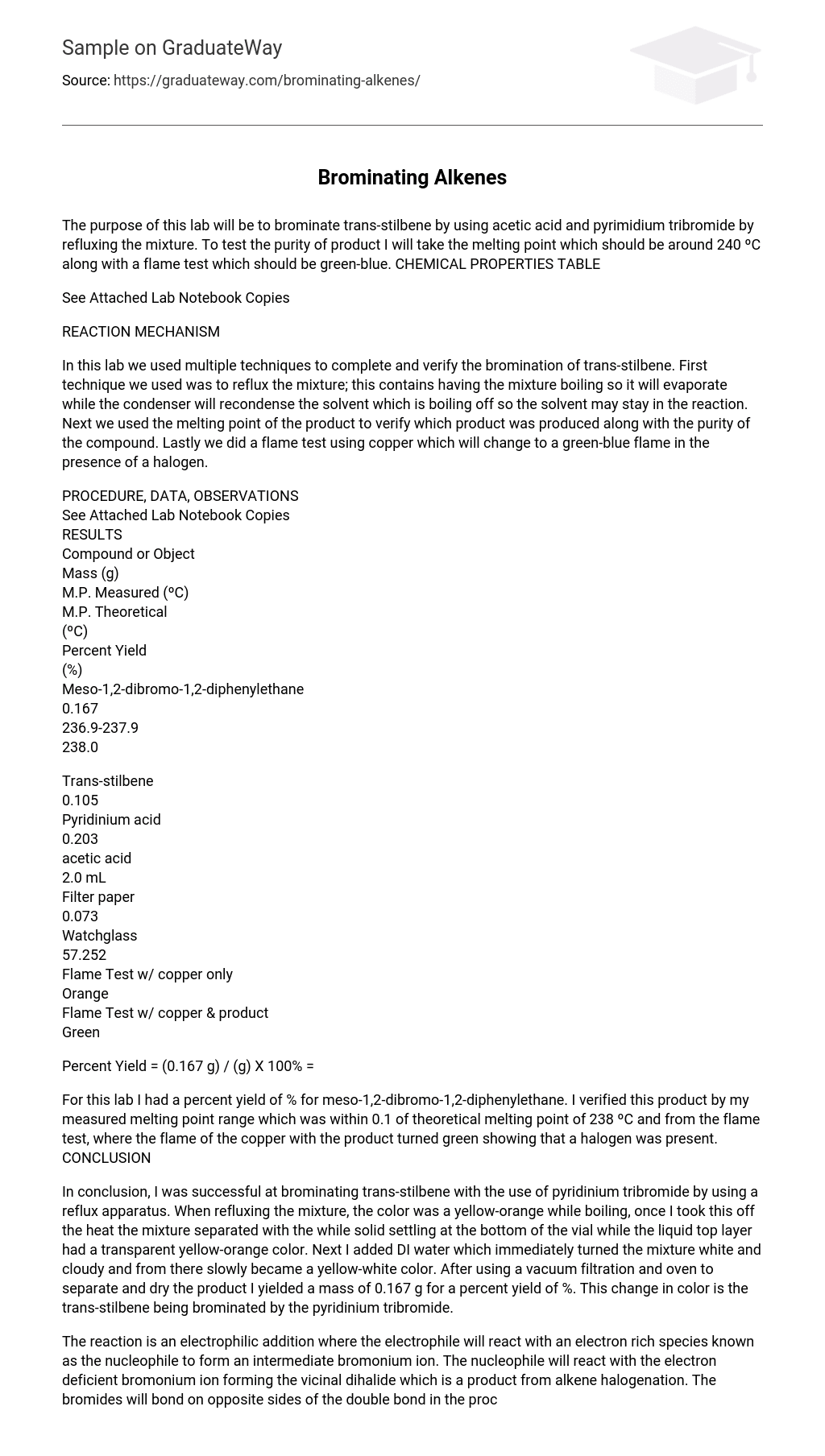The lab’s objective is to brominate trans-stilbene using a mixture of acetic acid and pyrimidium tribromide through refluxing. The resulting product’s purity will be determined by measuring its melting point, which is anticipated to be around 240 ºC. Furthermore, a flame test will be performed to observe a green-blue color. The following table presents the chemical properties:
See the attached copies of the lab notebook.
REACTION MECHANISM
The lab utilized various techniques to achieve and confirm the bromination of trans-stilbene. One method involved refluxing the mixture, which entailed boiling the mixture and ensuring that the evaporating solvent condensed back into the reaction by using a condenser. The resulting product’s melting point was then measured to determine its specific identity and purity. Finally, a flame test was conducted using copper, with the presence of a halogen causing the flame to turn green-blue.
PROCEDURE, DATA, OBSERVATIONS
See Attached Lab Notebook Copies
RESULTS
Compound or Object: Meso-1,2-dibromo-1,2-diphenylethane
Mass (g): 0.167
M.P. Measured (ºC): 236.9-237.9
M.P. Theoretical (ºC): 238.0
Trans-stilbene
0.105
Pyridinium acid
0.203
acetic acid
2.0 mL
The percent yield can be calculated using the formula (0.167 g) divided by (g) multiplied by 100%.
During the experiment, I achieved a percent yield of % for meso-1,2-dibromo-1,2-diphenylethane. To verify the product, its melting point range was measured and found to be within 0.1 ºC of the expected value of 238 ºC. Furthermore, a flame test was performed using copper ignited with the product, resulting in a green flame which suggests the presence of a halogen. In conclusion,
In summary, the bromination of trans-stilbene using pyridinium tribromide resulted in successful outcomes. The use of a reflux apparatus led to a yellow-orange color during boiling. Upon cooling, the mixture separated with a while solid settling at the bottom and a transparent yellow-orange liquid top layer. Adding DI water caused the mixture to turn white and cloudy, gradually transitioning to a yellow-white color. The product was separated and dried using vacuum filtration and an oven, resulting in a mass of 0.167 g. This corresponds to a percent yield of %. The change in color signifies the bromination of trans-stilbene by pyridinium tribromide.
The reaction is an electrophilic addition in which the electrophile reacts with a nucleophile to form a bromonium ion. The nucleophile then reacts with the bromonium ion to create a vicinal dihalide, which is a product of alkene halogenation. The bromides attach to opposite sides of the double bond through anti-addition, resulting in the formation of a trans vicinal dihalide and a meso dibromide for meso-1,2-dibromo-1,2-diphenylethane. This compound has two chiral carbons with an internal plane of symmetry, making its superimposable mirror images meso. In this lab, potential sources of error include incomplete refluxing of the mixture and insufficient cooling, leading to a lower percent yield. There may also be loss of product during filtration using the Hirsch funnel and some product may remain in the conical vial. POST-LABORATORY QUESTIONS
1a. The measured melting point of the product for the fast ramp was 235.9 – 244.0 ºC, and for the slow ramp was 236.9 – 237.9 ºC, thus confirming the production of meso-1,2-dibromo-1,2-diphenylethane.
1c. As I have not received the returned pre-lab assignment yet, I am uncertain about question 4.
2. Percent Yield = (0.167 g) / (g) X 100%.
3a. Instead of using silver nitrate in this lab, we conducted a flame test to verify the presence of a halogen.
3b. By placing a copper wire into a flame and observing an orange flame, and then introducing the produced product to the end of the copper wire and placing it into the flame again, a green flame was observed, confirming the presence of the halogen Br.
4.





